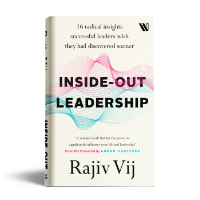A healthy sense of well-being is really important to all of us. Well-being is often one of the top wishes (possibly along with happiness and wealth) that people have for themselves and their loved ones. As people age, other than financial security, well-being and longevity are what they long for. Despite that yearning, how much attention do we pay to our overall sense of well-being on a regular basis? Even if we do, it’s often directed primarily towards our physical health – centered on the exercise routine and possibly some watchful eating. That is hardly sufficient attention, as our more complete sense of well-being emanates not just from improving our physical but also mental, emotional, and spiritual health. According to a Harvard Medical School publication, “Recurrence of cardiovascular events, including heart attacks and strokes, is more closely linked to depression than to high cholesterol, smoking, high blood pressure, or diabetes.” – reinforcing the importance of mental/ emotional health. Similarly, highlighting the need to nurture our soul, Roman philosopher Cicero said, “Diseases of the soul are more dangerous and more numerous than those of the body.” Taking a cue from the above, in this post, I would like to highlight the relevance of a more integrated approach to well-being, one that encapsulates healing and growth on all these four levels.
What are these different levels of healing and well-being? Physical well-being relates to our ability to effectively conduct various physical activities, including recreational ones, without any pain. It entails being physically healthy and inculcating healthy habits – taking care of our body through physical exercise, eating habits, hygiene, and maintaining effective balance between work and rest. Mental well-being is related to our intellect – our ability to think, our thoughts, understanding, values and beliefs. It facilitates our ability to create suitable mental maps to effectively navigate the world. Emotional well-being talks to our emotional health. As Mother Teresa said, “There is more hunger for love and appreciation in this world than for bread.” It’s the ability to understand our emotions, connect with others and their emotions, ability to face failure, resilience and so forth. It is critical for building meaningful relationships, at both work and home. It is also relevant in our ability to deal with the ups and downs of life. Spiritual well-being is connected with our levels of self-awareness, clarity about purpose of life, and our state of being. It is about knowing who we are, our place in this universe, and our interconnectedness.
For our true well-being, it’s important to make progress across all the four levels of well-being, without which we continue to experience a sense of incompleteness in our inner self. Physical well-being entails taking care of all aspects of our body – building endurance, strength, balance, and flexibility as well as eating a balanced diet. It also requires paying attention to the signals emitted by our body – towards rest, sleep, pain, and any illness. Every illness offers the opportunity to learn further about our body and engage in greater healing. Mental healing involves becoming more aware of our thoughts and beliefs; recognizing that the mental maps we have developed to navigate the ways of the world are not necessarily the reality; being open-minded towards new ideas and approaches; and addressing our inner mental scripts that often hold us back. Emotional well-being relies a lot on overcoming the delimiting emotional experiences of our childhood, a time where we are constantly judged and get used to suppressing our natural emotions. Healing in this area requires becoming better aware of our inner emotions, getting comfortable with experiencing the entire range of them, openly sharing them, being authentic in our interactions, and connecting with the true love that exists deep inside each of us. This not only allows us to be our true free self (please read the post on “being myself”), but also supports our ability to freely give and receive love. Spiritual well-being necessitates undertaking a journey within to connect with our core inner being, discovering our real purpose in life, learning to be present in the moment, and building equanimity under all situations. Progress in this area gives greater meaning to our lives and helps us to be happier and more peaceful.
While the above are some suggestive thoughts towards a more wholesome well-being, there is no one way to progress on this. It’s likely that we are already more developed in one/ some of these areas and may choose to begin working on the others. Different people may also find different approaches equally powerful and relevant for their personal situation. Sometimes, specific events, like layoff at work, a major health problem, or a deeply troubled relationship, can trigger the need for us to examine our lives more deeply. For others, it just maybe a broader sense of dissatisfaction with their existing life. However, all these areas are often interrelated and progress on any one may have a ripple effect on the others as well – learning about our inner self (spiritual) may allow us to better understand the source of our thoughts (mental) and feelings (emotional) too. Likewise, working with our feelings and relationships (emotional) may require an enhanced level of acceptance and letting go, resulting in spiritual growth. Similarly, it’s not uncommon to see physical challenges linked with deeper emotional issues. One of the recent winners of “The biggest loser”, a reality TV show about a competition to lose the maximum weight, described how his real breakthrough came by overcoming his discomfort with expressing his true emotions. He mentioned that he had previously been storing those emotions inside (akin to storing fat) and often resorted to overeating to overcome his emotional inadequacy. I have also written in the past about the interplay of our thoughts and emotions with what we experience in our bodies (please read “where is our mind located”).
All the same, while there are fairly well-established links between physical illness and psychological well-being, these linkages do not fully account for all our experiences. This maybe an important distinction, worth remembering, particularly when we are suffering from any significant physical or emotional challenges. With the modern society’s focus on individuality and the new age beliefs around “we create our own reality”, it’s possible for us to blame ourselves and have self-pity for every unsatisfactory state we find ourselves in. Now, every illness probably has a psychological aspect and every healing process is similarly influenced by psychology. However, as Steven Locke and Douglas Colligan write in “The Healer Within”, the challenge is that we maybe confusing psychosomatic (physical disease can be affected by psychological factors) with psychogenic (meaning illness is caused solely by psychological factors). There can obviously be other factors that influence physical health, like heredity, age, occupation, drugs, and living environment. One could perhaps add karma and other spiritual factors to the list too. In that context, I found Ken Wilbur’s perspective, of treating the illness at the level it exists at, quite insightful. That suggests treating a purely physical issue (fracture) at the physical level (fixing the fracture) and a psychosomatic issue (frequently getting a fracture) at a physical (fixing the fracture) and emotional level (understanding the emotional issues that attract accidents) and so forth. As he describes in “Grace and Grit”, treating a hurt at a level higher than required generates guilt; treating it at a lower level generates despair. Believing that the fracture was caused by our thoughts alone and trying to treat it with purely a mental level technique, like visualization, can lead us to feeling guilty and blaming ourselves. Alternately, someone suffering from low self-esteem (a mental, emotional issue) maybe best healed with mental-emotional tools of visualization, affirmations, and therapy; just focusing on diet will likely lead to despair in this case. Similarly, meditation and spiritual exercises maybe best suited for spiritual healing.
It is evident that we need to regularly create time and space to take stock of our lives and reflect on the state of our personal growth. As we become more self-aware and make a conscious effort towards healing areas that require attention, we begin to experience a greater sense of well-being. Further, developing an attitude, of learning and growing from every difficult challenge, facilitates this journey and gives us strength and inner peace. As we heal ourselves, we support the process of healing the world too.
Related Search Terms:
sense of well-being /happiness and well being /sense of wellbeing /general sense of well being /well being and happiness /happiness well being











 Personal Mastery and Parenting
Personal Mastery and Parenting This New Year, Realise You Are Enough
This New Year, Realise You Are Enough Nature Doesn’t Rush, Yet Accomplishes Everything: Reflections For The Restless
Nature Doesn’t Rush, Yet Accomplishes Everything: Reflections For The Restless This New Year: Whatever Your Goals, Try Practicing This
This New Year: Whatever Your Goals, Try Practicing This Reinventing Yourself In VUCA Times
Reinventing Yourself In VUCA Times
Interesting. I agree it takes be happy on all levels so really maintain well-being.It takes time too and I watch many people cut corners due to time. But then perhaps, less TV and computer time and more meditation, writing and movement time would work!
Cynthia Christianson
Self-improvement Coach
http://www.keepmovingforwardblog.com